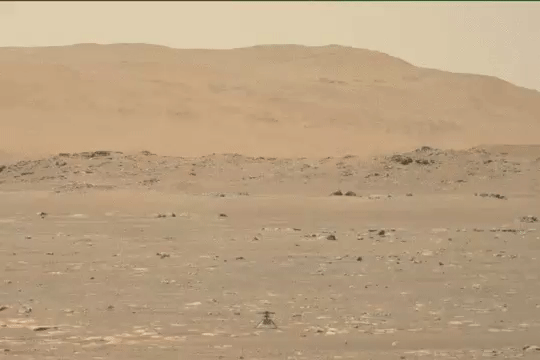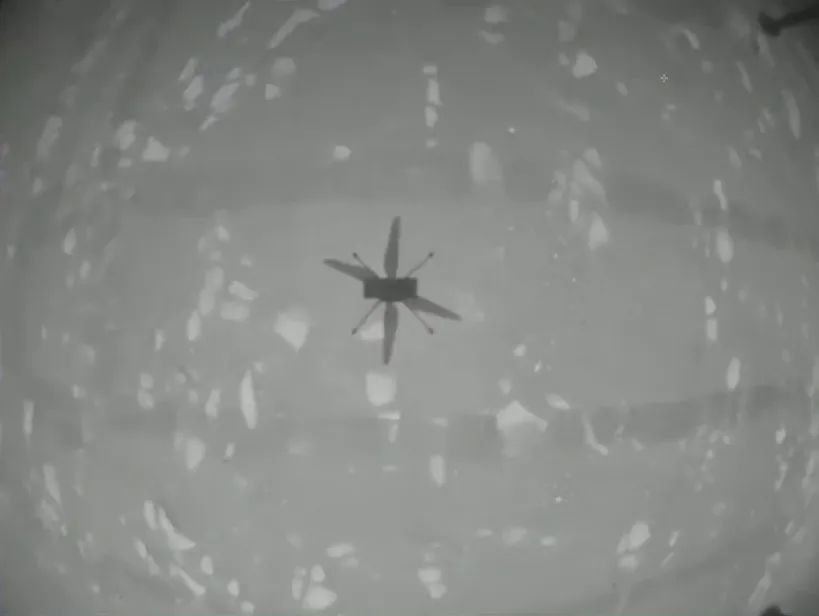NASA announced Thursday that the “Smart” unmanned helicopter successfully completed its first flight to Mars, with a flight time of 39.1 seconds, the first controlled flight of an artificial aircraft on another planet.
At 12:34 p.m. Pacific time on Thursday, the helicopter rose to a height of 3 meters and made a planned 96-degree turn before landing safely on the surface of Mars, Nature reported.

Small and fast! Helicopter rotor speeds exceed 2400 rpm
The flight was delayed by a week and was scheduled to begin on 11 April, but the helicopter was unable to make the transition to flight mode two days before the test flight due to software problems.
Weighing about 1.8kg, the Smart has four rotors that are powered by solar panels that charge lithium batteries. Mimi Ang, chief engineer at NASA’s Jet Propulsion Laboratory, said the biggest challenge for the Smart’s originality was to make it small enough and light enough to be carried into space by Perseverance and fly independently.
In order to fly in Mars’ thin atmosphere, The Smart has larger blades than a similar-sized helicopter on Earth, with four specially designed carbon fiber blades arranged in two rotors that rotate in the opposite direction at a rate of more than 2,400 revolutions per minute, faster enough to lift it into the Martian sky.
The purpose of The Wit is to test whether helicopters can be used to explore other worlds beyond earth. As it flies over the terrain, it takes black-and-white images of the surface below, as well as color images facing the horizon. Future helicopters could cross the surface, help lunar rovers, and even astronauts scout the area ahead and transmit landscape images.
Keep flying! Four flights over the next two weeks will push the limits
Over the next two weeks, the Smart is scheduled to make four more flights, each lasting 90 seconds. The next flight is tentatively scheduled to begin on 22 April. At that time, the “smart” goal is to fly 5 meters off the ground, horizontal flight of about 2 meters, and then fly back 2 meters, and finally landed at the take-off site. In the final flight, the helicopter may fly faster and farther, 300 meters from the take-off point.
It is reported that every successive flight will promote the performance of the Smart. Mars’ atmosphere is only 1% denser than Earth’s, and scientists want to test how well helicopters behave in the planet’s thin atmosphere.
“We will push the limits.” “Ultimately, the ‘smart’ is likely to come to the point where it collapses because of our design, ” says Ang. ”
Previously, space agencies had sent spacecraft that could float in the air to other planets; in 1985, for example, the Soviet Union sent two spacecraft containing atmospheric balloons and landers: Vega I and II, into Venus’ atmosphere. But the “smart” flight was the first controlled flight on an extraterrestrial planet.
There’s eggs! The helicopter carried fabric from the Wright brothers plane
The significance of the “smart” short-haul test flight is equivalent to the significance of the Wright brothers’ first test flight of an artificial aircraft on Earth in 1903. In honor of the Wright brothers, the helicopter carried a piece of tulle fabric the size of a stamp taken from the Wright brothers’ plane.
On February 18 this year, Smart landed on Mars aboard the Perseverance rover. Perseverance travels from the landing site to a relatively rockless flat “airport” in the Jezero Crater, where it drops the “smart”. The Perseverance was then in a vantage point 65 metres away, watching and filming the first take-off and flight of the Smart.
Engineers say they are waiting for information on how much power the Smart helicopter needs to hover, which will help engineers better understand the aerodynamics and electrical properties on Mars.
Smart will only last on Mars for 30 days, with a deadline of May 4. After that, the team’s scientists will turn their attention back to the Mars rover Perseverance. Perseverance embarked on a journey to collect rock samples and eventually returned to Earth, and the tactful, which once landed in the Jezero crater, will remain there forever.
Go to Saturn! NASA explores extraterrestrial planets and has new movements
NASA is reportedly already building a car-sized octagonal vehicle called the Dragonfly, which it plans to send to Saturn’s moon, Titan. The helicopter, scheduled for launch in 2027, will explore Saturn’s atmosphere, which is four times denser than Earth’s atmosphere and rich in primitive organic compounds, in contrast to the environment in which Ingenious experienced on Mars.
In addition, early flight experience from the Smart will inform the design of the Tmny. Elizabeth Teitel, a planetary scientist at Johns Hopkins University’s Applied Physics Laboratory and lead researcher on the project, said: “We look forward to learning from the experience of the ‘Smart’ team in outer space. ”



